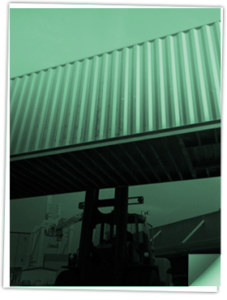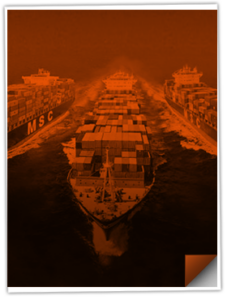Featured Headlines:
Tariffs, Tonnage, and Transpacific Turbulence
Digital Forwarders: From Hype to “Help?”
CBP Applies ACE Bandage to Section 232 Duties on Aluminum Items
USTR Shares its 2025 Trade "Notes" with the Class
Cargo Crime Is Booming—and Congress Might Finally Care
Port Pain Points: NSAC Wants the Dirt
Tariffs, Tonnage, and Transpacific Turbulence
- Just when shippers thought they’d caught a break, the Trump administration tossed another wrench into the gears with yet more trade policy plot twists.
- Tired of the whiplash, many shippers locked in transpacific contracts at slightly higher rates—about $200 more per 40-foot container than last year—per Linerlytica.
- These new contracts come loaded with surcharge provisions just in case the US Trade Representative manages to push through proposed port fees on Chinese-built ships, but any such fees likely wouldn’t hit until November… Or will they?!
- Carriers aren’t taking chances: charter agreements are being updated so charterers, not owners, will have to absorb more of those fees.
- Freight rates got a jolt in late March: Shanghai to US West Coast jumped 16%, while East Coast rose 11%, thanks to GRIs and MSC canceling many transpacific sailings.
- Wan Hai and Yang Ming are feeling confident, citing higher rates and route detours caused by the unstable Israel-Hamas ceasefire.
- But overall demand? Still dragging. Post–Chinese New Year volumes flopped, and 2025 is now projected to see a 1.1% drop in container volume, with no big bounce expected for peak season.
Digital Forwarders: From Hype to “Help?”
- The digital freight forwarding fairytale is hitting reality—with Forto and EV Cargo up for sale, and Flexport admitting it missed its 2024 profitability target.
- This second wave of digital disruption isn’t about innovation anymore—it’s about running out of capital, running out of patience, and in some cases, just plain running out of steam.
- Flexport, once valued at $8B, is now pegged closer to $3.8B, and that’s being generous. Too much warehouse space, too little demand—and no IPO in sight.
- Shopify, which owns a 17% stake, logged a $22M loss on Flexport last quarter. Ouch.
- As cheap capital dries up and interest rates hover high, digital-first freight players are learning the hard way: growth requires cash, not just code.
- “Digital poster child” Flexport is trading on the secondary market, but shares are discounted—and investors are circling for a chance to cash out.
- The once-blazing VC spotlight is dimming, with many questioning whether this model can thrive without massive balance sheet backing from more traditional players.
CBP Applies ACE Bandage to Section 232 Duties on Aluminum Items
- Listen up, folks…because this one is important!
- US Customs and Border Protection (CBP) has alerted the trade to an error within the Automated Commercial Environment (ACE) regarding the Section 232 duties recently applied to aluminum derivative items.
- According to CSMS # 64605146, ACE mistakenly required Section 232 duties to be applied on aluminum derivative articles classified under 8418.99.8010, 8418.99.8015, 8418.99.8020 and 8418.99.8025 using the HTS code of 9903.85.08 effective March 12, 2025.
- However, these classifications are not actually included in the Final List of Aluminum HTS Codes Subject to Section 232.
- This has been corrected in ACE effective March 27, 2025.
- For goods entered on or after March 12, 2025, classified under the HTSUS code above, importers should file a post summary correction (PSC) to remove the bad code (9903.85.08) and receive a refund of the Section 232 duties paid.
- PSCs can be filed on any unliquidated entries to request a refund of duties paid under a trade remedy. Once an entry has been liquidated, a protest may be filed within 180 days of the liquidation date.
- For more information on the classifications of aluminum derivative items subject to the order, please refer to the following:
USTR Shares its 2025 Trade "Notes" with the Class
- This week, the US Trade Representative (USTR) submitted its 2025 National Trade Estimate (NTE) in the eleventh hour—a theme that seems to be appearing quite frequently with the current administration!
- The NTE reports on foreign trade barriers U.S. exporters face and USTR’s efforts to reduce them.
- It’s prepared on an annual basis utilizing various inputs across US government agencies, embassies, and public comments and then submitted to the President and Congress by March 31.
- Not shockingly, the 2025 report aligns with President Trump’s America First Trade Policy and his 2025 Trade Policy Agenda.
- Specifically, Ambassador Greer highlighted President Trump’s focus on addressing unfair trade practices and prioritizing American businesses and workers.
- We know the world is bogged down with tariffs, so we won’t bore you with the fine print. If you are interested in reading the full report, please refer to the 2025 National Trade Estimate Report.
Cargo Crime Is Booming—and Congress Might Finally Care
- Cargo theft isn’t just a headache anymore, it’s a full-blown epidemic, with 2024 thefts up 27% and strategic fraud evolving faster than ever.
- The Feds are scrambling. Transportation groups are backing two key bills, including the Safeguarding our Supply Chains Act, which would create a multi-agency federal task force to crack down on cargo crime. Wait, which federal agencies still exist?!
- The Act would also inject $100 million over five years into fighting theft and fraud; and finally force agencies to share data instead of playing the blame game.
- Right now, enforcement is fragmented: ICE, Homeland Security, and local police all have pieces of the puzzle, but no one’s holding the full picture.
- Worse? Cargo theft is wildly underreported—or misreported. Think: stolen load logged as a “vehicle theft” or simple fraud.
- Experts estimate the real number of annual cargo thefts is closer to 100,000—not the 3,600-ish officially reported.
- The proposed task force won’t solve everything, but it could finally bring coordination, clearer reporting, and shared accountability across federal and local levels.
Port Pain Points: NSAC Wants the Dirt
- The National Shipper Advisory Committee (NSAC) is putting ports under the microscope—and they want to hear directly from truckers and terminals about the chaos inside the gates.
- The focus? Three infamous trouble spots:
- Early return dates
- Empty container returns
- Availability of containers
- Starting with the Northwest Seaport Alliance, a small task force has been formed to map what’s really happening at terminals and brainstorm ways to boost throughput.
- The effort is part of the Port Best Practices Subcommittee, which ultimately hopes to create scalable solutions that can be adopted across other U.S. ports.
- No solid timeline yet, but monthly and bi-monthly meetings are in the works and they’re actively calling on truckers and terminal operators to speak up.
- IKEA’s Debb Minskey, who’s heading the committee, kept it real: “Ultimate goal? We want to see things improve.”
- So, if your containers are playing hide-and-seek or early return windows are wrecking your flow, now’s your chance to get your gripes on the record.



